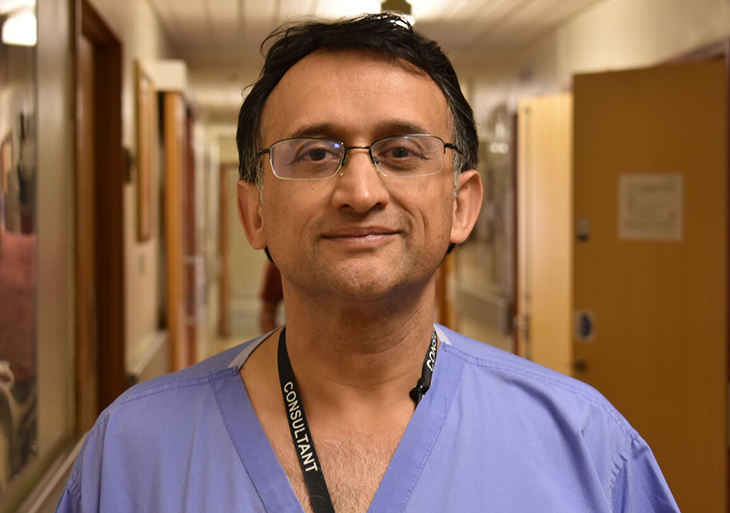In 2022, the Trust finalised plans to improve cardiology services across East Sussex, following a public consultation and review by NHS Sussex and East Sussex County Council.
Professor Nik Patel, Consultant Cardiologist and lead for the transformation project, explains what’s changing and why.

Why are these changes happening? Was the existing service failing?
I’ve worked in as a cardiology consultant in East Sussex for the last 26 year, and my goal has always been simple: to give patients the best possible care. These changes are about achieving exactly that, helping more people have faster access to and better outcomes from their care.
Our teams are dedicated and deliver excellent care, but when we reviewed the service, it became clear we weren’t structured in the best way to meet new national standards and future proof it to meet new standards in the future. Across the country, cardiology has evolved, and we needed to take action to keep pace.
Some improvements, like establishing Cardiac Response Teams at both hospitals, have already made a positive impact. Others, such as moving all specialist cardiology inpatient and interventional services to one site, understandably cause concern, but they will ultimately mean better care for everyone.
These plans were not drawn up in isolation, but with the input of national clinical experts in this field. The NHS England Getting It Right First Time (GIRFT) team, led by the National Clinical Director for Heart Disease at NHS England and, at the time, a former President of the British Cardiovascular Society, came to see our twin-site model and made a clear recommendation that we needed to locate our specialist cardiology inpatient and interventional services on one site.
Do the changes mean there won’t be any cardiology care at Conquest Hospital?
Not at all. Conquest Hospital will continue to provide the cardiology services 95% of local patients require. Heart-failure beds, cardiac monitoring, non-invasive diagnostics, cardiac rehabilitation, and outpatient appointments will all remain in place.
Patients attending the emergency department at Conquest Hospital will also benefit from our new Cardiac Response Team, ensuring faster access to specialist cardiology care when it’s needed. Only specialist cardiology inpatient and interventional services are moving and this represents less than 5% of activity.
Why move all specialist cardiology inpatient and interventional services to one site?
Cardiology practice has changed dramatically. Evidence shows patients have better outcomes when services meet modern standards, including minimum activity levels for procedures and having the right facilities in place.
When teams are split across sites, each may not see enough patients to maintain the skills and experience required. By bringing them together, we ensure our clinicians stay at the top of their game, just as a musician improves through regular performance.
The other factor is infrastructure. Complex cardiology units should have at least two cardiac catheter labs to ensure continuity if one is under maintenance. Eastbourne DGH meets this standard; Conquest currently does not.
If I have a heart attack in Hastings, isn’t Eastbourne too far?
That’s a very understandable concern, but the short answer is no.
Firstly, only a small number of cardiology patients need an immediate complex procedure requiring an emergency transfer. Most are seen through planned appointments, and many don’t need complex interventions at all.
Secondly, national guidance shows that short travel times, similar to those between Hastings and Eastbourne, do not affect patient outcomes. What matters most is being treated by a skilled, well-resourced specialist team; this makes the difference in patient outcomes far more than whether a patient travels further.
It’s also worth noting that we already alternate specialist cardiology interventional services weekly between our Eastbourne and Hastings sites, meaning half of patients are already transferred and safely treated at the other hospital. For patients that live around Rye and the eastern most areas of the county, they will continue to be treated for heart attacks at Ashford as they currently do on an alternate week, with full support from the ambulance crew who attend them.
What about visitors who have to travel further?
I completely understand how difficult that can be, especially for people without easy transport. This was one of the hardest aspects of the decision. However, patients will recover more quickly and with fewer complications under the new model, benefits that outweigh the inconvenience of longer journeys to visit.
Why are the changes happening now, when the plans were drawn up three years ago?
Our plan has always been to deliver these improvements in stages and since our plans were approved in 2022 we have been working constantly to get all aspects of the programme fully designed, planned and the necessary physical space refurbished and ready to provide patient care.
We’ve already introduced our Cardiac Response Teams, and patients are benefiting from them right now; the building work phase has taken slightly longer than anticipated to complete, by about six months, to ensure it was fully coordinated with other building work on our sites to improve our hospitals without disrupting patient care.
Is this part of a wider pattern of removing services from Conquest Hospital?
Not at all. Both hospitals play vital roles. Conquest Hospital hosts services such as paediatric inpatient care, our consultant-led maternity unit, and most urgent complex surgery. Eastbourne has its own specialisms. This is about making both hospitals strong, complementary centres of excellence.
We recognise the need for strong health services to support the public health needs of our Hastings population. In keeping with the government’s plans for the NHS, our thinking is focused on getting the right type of service in the right location, and this means considering preventative care and care in community settings too.
Some people say this is about saving money – is that true?
No. These changes are driven by quality, not cost. While improved efficiency can save money in some areas, that’s not the goal. In fact, we’ve invested in new services like the Cardiac Response Teams. The priority has always been, and remains, better care for our patients.
